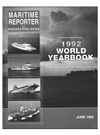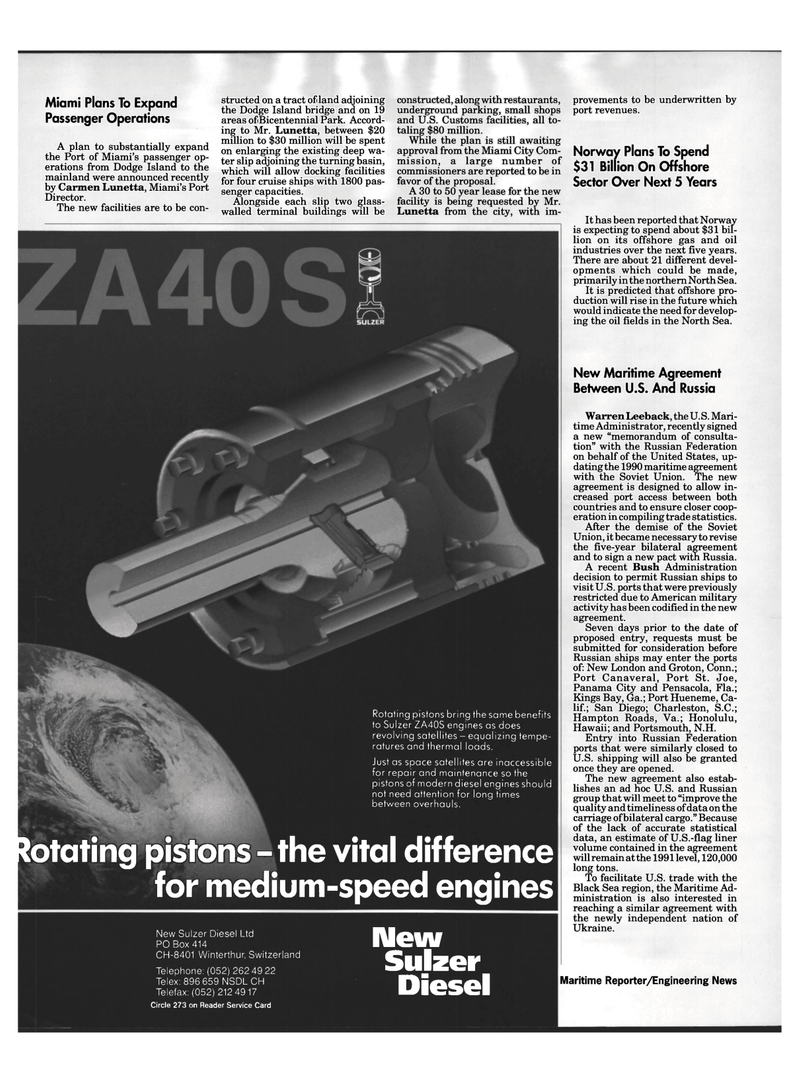
Page 4: of Maritime Reporter Magazine (June 1992)
Read this page in Pdf, Flash or Html5 edition of June 1992 Maritime Reporter Magazine
Miami Plans To Expand
Passenger Operations
A plan to substantially expand the Port of Miami's passenger op- erations from Dodge Island to the mainland were announced recently by Carmen Lunetta, Miami's Port
Director.
The new facilities are to be con- structed on a tract of land adjoining the Dodge Island bridge and on 19 areas of Bicentennial Park. Accord- ing to Mr. Lunetta, between $20 million to $30 million will be spent on enlarging the existing deep wa- ter slip adjoining the turning basin, which will allow docking facilities for four cruise ships with 1800 pas- senger capacities.
Alongside each slip two glass- walled terminal buildings will be constructed, along with restaurants, underground parking, small shops and U.S. Customs facilities, all to- taling $80 million.
While the plan is still awaiting approval from the Miami City Com- mission, a large number of commissioners are reported to be in favor of the proposal.
A 30 to 50 year lease for the new facility is being requested by Mr.
Lunetta from the city, with im- provements to be underwritten by port revenues.
Norway Plans To Spend $31 Billion On Offshore
Sector Over Next 5 Years
It has been reported that Norway is expecting to spend about $31 bil- lion on its offshore gas and oil industries over the next five years.
There are about 21 different devel- opments which could be made, primarily in the northern North Sea.
It is predicted that offshore pro- duction will rise in the future which would indicate the need for develop- ing the oil fields in the North Sea.
New Maritime Agreement
Between U.S. And Russia
Warren Leeback, the U.S. Mari- time Administrator, recently signed a new "memorandum of consulta- tion" with the Russian Federation on behalf of the United States, up- datingthe 1990 maritime agreement with the Soviet Union. The new agreement is designed to allow in- creased port access between both countries and to ensure closer coop- eration in compiling trade statistics.
After the demise of the Soviet
Union, it became necessary to revise the five-year bilateral agreement and to sign a new pact with Russia.
A recent Bush Administration decision to permit Russian ships to visit U.S. ports that were previously restricted due to American military activity has been codified in the new agreement.
Seven days prior to the date of proposed entry, requests must be submitted for consideration before
Russian ships may enter the ports of: New London and Groton, Conn.;
Port Canaveral, Port St. Joe,
Panama City and Pensacola, Fla.;
Kings Bay, Ga.; Port Hueneme, Ca- lif.; San Diego; Charleston, S.C.;
Hampton Roads, Va.; Honolulu,
Hawaii; and Portsmouth, N.H.
Entry into Russian Federation ports that were similarly closed to
U.S. shipping will also be granted once they are opened.
The new agreement also estab- lishes an ad hoc U.S. and Russian group that will meet to "improve the quality and timeliness of data on the carriage of bilateral cargo." Because of the lack of accurate statistical data, an estimate of U.S.-flag liner volume contained in the agreement will remain at the 1991 level, 120,000 long tons.
To facilitate U.S. trade with the
Black Sea region, the Maritime Ad- ministration is also interested in reaching a similar agreement with the newly independent nation of
Ukraine. 6 Maritime Reporter/Engineering News
Rotating pistons bring the same benefits to Sulzer ZA40S engines as does revolving satellites - equalizing tempe- ratures and thermal loads.
Just as space satellites are inaccessible for repair and maintenance so the pistons of modern diesel engines should not need attention for long times between overhauls.
Rotating pistons - the vital difference for medium-speed engines
New Sulzer Diesel Ltd
PO Box 414
CH-8401 Winterthur, Switzerland
Telephone: (052) 262 49 22
Telex: 896 659 NSDL CH
Telefax: (052) 212 4917
Circle 273 on Reader Service Card
New Sulzer
Diesel

 3
3

 5
5
